Expression of the maize ZmGF14-6 gene in rice confers tolerance to drought stress while enhancing susceptibility to pathogen infection
- PMID: 22016430
- PMCID: PMC3254693
- DOI: 10.1093/jxb/err328
Expression of the maize ZmGF14-6 gene in rice confers tolerance to drought stress while enhancing susceptibility to pathogen infection
Abstract
14-3-3 proteins are found in all eukaryotes where they act as regulators of diverse signalling pathways associated with a wide range of biological processes. In this study the functional characterization of the ZmGF14-6 gene encoding a maize 14-3-3 protein is reported. Gene expression analyses indicated that ZmGF14-6 is up-regulated by fungal infection and salt treatment in maize plants, whereas its expression is down-regulated by drought stress. It is reported that rice plants constitutively expressing ZmGF14-6 displayed enhanced tolerance to drought stress which was accompanied by a stronger induction of drought-associated rice genes. However, rice plants expressing ZmGF14-6 either in a constitutive or under a pathogen-inducible regime showed a higher susceptibility to infection by the fungal pathogens Fusarium verticillioides and Magnaporthe oryzae. Under infection conditions, a lower intensity in the expression of defence-related genes occurred in ZmGF14-6 rice plants. These findings support that ZmGF14-6 positively regulates drought tolerance in transgenic rice while negatively modulating the plant defence response to pathogen infection. Transient expression assays of fluorescently labelled ZmGF14-6 protein in onion epidermal cells revealed a widespread distribution of ZmGF14-6 in the cytoplasm and nucleus. Additionally, colocalization experiments of fluorescently labelled ZmGF14-6 with organelle markers, in combination with cell labelling with the endocytic tracer FM4-64, revealed a subcellular localization of ZmGF14-6 in the early endosomes. Taken together, these results improve our understanding of the role of ZmGF14-6 in stress signalling pathways, while indicating that ZmGF14-6 inversely regulates the plant response to biotic and abiotic stresses.
Figures
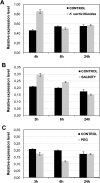
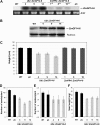
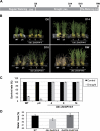
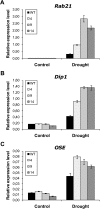
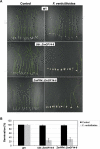

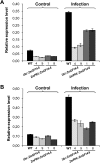

Similar articles
-
ERF Transcription Factor OsBIERF3 Positively Contributes to Immunity against Fungal and Bacterial Diseases but Negatively Regulates Cold Tolerance in Rice.Int J Mol Sci. 2022 Jan 6;23(2):606. doi: 10.3390/ijms23020606. Int J Mol Sci. 2022. PMID: 35054806 Free PMC article.
-
Overexpression of an AP2/ERF Type Transcription Factor OsEREBP1 Confers Biotic and Abiotic Stress Tolerance in Rice.PLoS One. 2015 Jun 2;10(6):e0127831. doi: 10.1371/journal.pone.0127831. eCollection 2015. PLoS One. 2015. PMID: 26035591 Free PMC article.
-
Enhanced heat and drought tolerance in transgenic rice seedlings overexpressing OsWRKY11 under the control of HSP101 promoter.Plant Cell Rep. 2009 Jan;28(1):21-30. doi: 10.1007/s00299-008-0614-x. Epub 2008 Sep 26. Plant Cell Rep. 2009. PMID: 18818929
-
Root Response to Drought Stress in Rice (Oryza sativa L.).Int J Mol Sci. 2020 Feb 22;21(4):1513. doi: 10.3390/ijms21041513. Int J Mol Sci. 2020. PMID: 32098434 Free PMC article. Review.
-
Transcription factors as molecular switches to regulate drought adaptation in maize.Theor Appl Genet. 2020 May;133(5):1455-1465. doi: 10.1007/s00122-019-03494-y. Epub 2019 Dec 5. Theor Appl Genet. 2020. PMID: 31807836 Review.
Cited by
-
Association of candidate genes with drought tolerance traits in diverse perennial ryegrass accessions.J Exp Bot. 2013 Apr;64(6):1537-51. doi: 10.1093/jxb/ert018. Epub 2013 Feb 5. J Exp Bot. 2013. PMID: 23386684 Free PMC article.
-
A major locus controlling malondialdehyde content under water stress is associated with Fusarium crown rot resistance in wheat.Mol Genet Genomics. 2015 Oct;290(5):1955-62. doi: 10.1007/s00438-015-1053-3. Epub 2015 May 5. Mol Genet Genomics. 2015. PMID: 25939503
-
Genetic dissection of drought and heat tolerance in chickpea through genome-wide and candidate gene-based association mapping approaches.PLoS One. 2014 May 6;9(5):e96758. doi: 10.1371/journal.pone.0096758. eCollection 2014. PLoS One. 2014. PMID: 24801366 Free PMC article.
-
Integrative transcriptome and WGCNA analysis reveal key genes mainly in response to Alternaria alternata in Populus simonii × P. nigra.Front Plant Sci. 2025 Feb 17;16:1540718. doi: 10.3389/fpls.2025.1540718. eCollection 2025. Front Plant Sci. 2025. PMID: 40034158 Free PMC article.
-
A maize phytochrome-interacting factor 3 improves drought and salt stress tolerance in rice.Plant Mol Biol. 2015 Mar;87(4-5):413-28. doi: 10.1007/s11103-015-0288-z. Epub 2015 Jan 31. Plant Mol Biol. 2015. PMID: 25636202
References
-
- Bihn EA, Paul A-L, Wang SW, Erdos GW, Ferl RJ. Localization of 14-3-3 proteins in the nuclei of Arabidopsis and maize. The Plant Journal. 1997;12:1439–1445. - PubMed
-
- Brandt J, Thordal-Christensen H, Vad K, Gregersen PL, Collinge DB. A pathogen-induced gene of barley encodes a protein showing high similarity to a protein kinase regulator. The Plant Journal. 1992;2:815–820. - PubMed
-
- Campo S, Carrascal M, Coca M, Abian J, San Segundo B. The defense response of germinating maize embryos against fungal infection: a proteomics approach. Proteomics. 2004;4:383–396. - PubMed
-
- Chen F, Li Q, Sun L, He Z. The rice 14-3-3 gene family and its involvement in responses to biotic and abiotic stress. DNA Research. 2006;13:53–63. - PubMed
-
- Chevalier D, Morris ER, Walker JC. 14-3-3 and FHA domains mediate phosphoprotein interactions. Annual Review of Plant Biology. 2009;60:67–91. - PubMed

